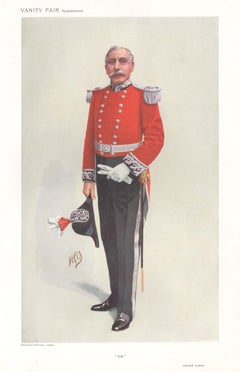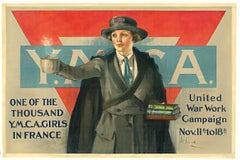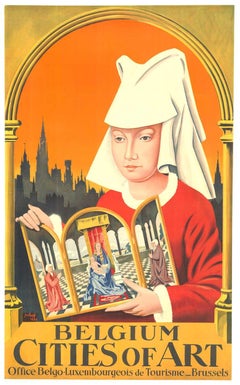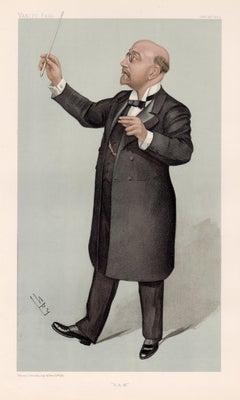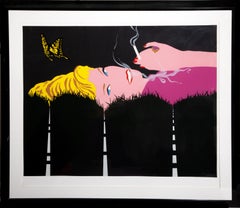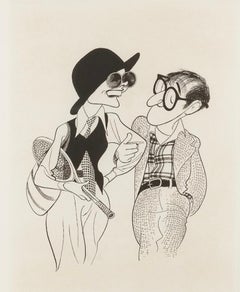20th Century Portrait Prints
to
946
1,635
757
1,192
515
271
Overall Width
to
Overall Height
to
1,122
796
354
282
158
130
110
88
75
15
9
6
4
79
78
76
70
67
337
1,502
4,390
2,434
63
132
194
156
237
235
481
848
640
339
275
3,494
752
105
3,310
1,785
1,672
1,295
1,238
654
624
580
477
440
323
313
294
229
167
113
107
86
77
76
2,241
834
738
407
306
728
1,359
2,760
1,384
Period: 20th Century
Vanity Fair 'Joe', portrait of Sir Joseph Lyons
Located in Melbourne, Victoria
'Joe'
Hentschel-Colourtype. 1910.
Vanity Fair portrait of Sir Joseph Lyons who founded the famous Cafe shops.
380mm by 265mm (sheet)
Category
Victorian 20th Century Portrait Prints
Materials
Lithograph
Original YMCA United War Work Campaign vintage World War 1 poster
By Neysa McMein
Located in Spokane, WA
Original 1918 YMCA, One of the Thousands of YMCA Girls in France. United War Work Campaign vintage poster. Archival linen backed and ready to frame. Some touch up in the lower b...
Category
American Realist 20th Century Portrait Prints
Materials
Lithograph
Original "Belgium Cities of Art" vintage poster 1932
Located in Spokane, WA
Original Travel Poster for Belgium - Cities of Art signed by artist Poleff and dated 1932. The image, framed in an archway window, features a woman wearing Byzantine / Middle Ages e...
Category
Gothic 20th Century Portrait Prints
Materials
Lithograph
$716 Sale Price
20% Off
Sir Alexander Mackenzie, composer, Vanity Fair caricature portrait, 1904
Located in Melbourne, Victoria
'R.A.M'
Chromolithograph. 1904.
Vanity Fair musician portrait of Sir Alexander Campbell Mackenzie (1847 - 1935) who was a Scottish composer, conductor and teacher best known for h...
Category
Victorian 20th Century Portrait Prints
Materials
Lithograph
Smoking Blonde, Pop Art Screenprint by Allan D'Arcangelo
Located in Long Island City, NY
Smoking Blonde
Allan D’Arcangelo, American (1930–1998)
Date: 1990
Screenprint, signed, numbered and dated in pencil
Edition of 57/65
Size: 37 x 46.5 in. (93.98 x 118.11 cm)
Frame Siz...
Category
20th Century Portrait Prints
Materials
Screen
$2,200 Sale Price
26% Off
Diane Keaton & Woody Allen "Annie Hall" Movie Oscar Academy Award Caricature
Located in New York, NY
Diane Keaton & Woody Allen "Annie Hall" Movie Oscar Academy Award Caricature
Al Hirschfeld (1903-2003)
Diane Keaton and Woody Allen in "Annie Hall"
Plate Size: 13 x 9 3/4
Paper Size...
Category
Performance 20th Century Portrait Prints
Materials
Paper, Etching
Young Woman - Original Lithograph by Charles Lucien Léandre - 1903
Located in Roma, IT
Young Woman is an original lithograph artwork, realized in 1903 by Charles Lucien Léandre (1862–1934).
Signed on plate on the lower left and dated.
Th...
Category
Modern 20th Century Portrait Prints
Materials
Lithograph
C.O. Paeffgen, Queen - Signed Print, 1992, Pop Art, Contemporary Portrait
Located in Hamburg, DE
C.O. Paeffgen (German, 1933-2019)
Queen, 1992
Medium: Offset lithograph on card stock
Dimensions: 49.5 x 50 cm
Edition of 100: Monogrammed, numbered and dated
Condition: Very good
Category
Pop Art 20th Century Portrait Prints
Materials
Offset
Original "Niagara", Marilyn Monroe, 1953 vintage movie poster half-sheet
Located in Spokane, WA
Original “Niagra” vintage movie poster 22” x 28” half-sheet for Marilyn Monroe film. (1953) Profession acid-free paper backed for conservancy and entirely unrestored original U.S. 22” x 28” half-sheet poster, long considered the best layout for this title due to the horizontal art of Marilyn Monroe posing atop Niagara Falls. Very Fine.
Looking for Marilyn Monroe, Niagra original vintage movie poster for your home theater?
Are you looking for a gift for your husband? A vintage poster could be an excellent choice. We are selling this 1953 original vintage half-sheet movie poster with Marilyn Monroe in “Niagra”. Are you looking for a new wall decor to add some personality to your home? We have a huge collection of vintage posters...
Category
American Modern 20th Century Portrait Prints
Materials
Offset
$1,480 Sale Price
20% Off
Vintage Hockney poster Kammer 1981 Celia in a Black Dress and Red Stockings
Located in New York, NY
Printed for Galerie Kammer’s 1981 David Hockney exhibition “Drawings and Prints”, this beautiful poster reproduces Hockney’s drawing Celia in a Black Dress and Red Stockings 1973. Fa...
Category
Realist 20th Century Portrait Prints
Materials
Lithograph
Original MOISSONS (harvest) Loterie Nationale 1939 vintage French poster
Located in Spokane, WA
MOISSON (harvest) Loterie Nationale original 1939 lithograph Artwork by Edgar Derouet (1910-2001) and Charles Lesacq (1909-1940). size 15" x 23", year 1939. Archival linen backed i...
Category
Art Deco 20th Century Portrait Prints
Materials
Lithograph
Woman in Green - Woodcut by Otto Lange - 1916
By Otto Lange b.1879
Located in Roma, IT
Woman in Green is a Colored print on paper, realized by Otto Lange in 1916
Woodcut on paper.
Good conditions.
Category
Modern 20th Century Portrait Prints
Materials
Woodcut
Original Go Over The Top With U..S. MARINES vintage WW1 antique poster
Located in Spokane, WA
Original World War 1 antique poster: Go Over The Top With U.S. Marines. Artist John Coughlin. Linen backed. Grade A, Excellent condition.
Rare W...
Category
American Realist 20th Century Portrait Prints
Materials
Lithograph
Head of Demeter of Cnidos British Museum Roman Classical sculpture photogravure
Located in Melbourne, Victoria
'Head of Demeter of Cnidos'
Photogravure from a collection of photogravures depicting Greek and Roman marbles and bronzes in the British museum. Plate number above top right corner ...
Category
Other Art Style 20th Century Portrait Prints
Materials
Photogravure
LES QUATRE SAISONS DE L'AMOUR 4 Signed Lithographs Clamshell Case, Paris Lovers
Located in Union City, NJ
LES QUATRE SAISONS DE L'AMOUR is a very distinctive boxed set of 4 signed original hand drawn limited edition lithographs in a red clamshell box by ...
Category
Contemporary 20th Century Portrait Prints
Materials
Lithograph
LOUISIANA SERENADE Signed Lithograph, Two Men Playing Guitars, Woman on Veranda
Located in Union City, NJ
LOUISIANA SERENADE is a limited edition color lithograph by the renowned African American artist Romare Bearden, printed on archival Somerset printmaking paper, 100% acid free, in an edition size of 175. LOUISIANA SERENADE, from Bearden's late 1970's colorful JAZZ series of musical imagery, captures a Southern evening depicting two male figures playing their guitars on the veranda while a seated woman sits listening beside a glowing glass chimney lamp. LOUISIANA SERENADE, printed in lush hues of green, red, yellow, purple, blue presents a free flowing watercolor-like abstract music portrait by the renowned American artist Romare Bearden.
Print size - 24.5 x 33.75 inches, unframed, excellent condition, fresh colors, full bleed image, no margins, hand signed in pencil by Romare Bearden, printer's chop mark embossed on lower edge, print documentation provided
Year Published - 1979
Edition size - 175, plus proofs
About the artist-
Romare Bearden (1911-1988)
Born in Charlotte, North Carolina, Romare Bearden is one of America’s most esteemed African American contemporary artists. Bearden grew up in the Harlem neighborhood of New York City and attended New York University where he received a degree in mathematics. Following graduation, Bearden turned his attention to art, pursuing further studies with George Grosz at the Art Students League.
The artist served in the United States Army from 1942 to 1945. After leaving the Army, Bearden used funds from the GI Bill to travel to Europe for six months to study art history and philosophy at the Sorbonne. During this trip, Bearden had the opportunity to meet Henri Matisse, Georges Braque and Joan Miro, all of who had a strong influence on his artwork.
Bearden’s work on canvas and collages expressed the complexities of rural Black America. “My intention is to reveal through pictorial complexities of the life I know,” he said. He integrated scenes from his childhood in North Carolina and from New York City, including many rituals and social customs. Another theme throughout his work was music. Bearden grew up surrounded by musicians and loved jazz and blues.
Romare Bearden’s artwork can be found in numerous permanent collections around the country including the Museum of Modern Art and the Metropolitan Museum of Art. Retrospective exhibitions of Bearden’s art have been held by The Mint Museum of Art, Charlotte; the Museum of Modern Art; the Detroit Institute; and the Studio Museum in Harlem. As well, President Reagan...
Category
Contemporary 20th Century Portrait Prints
Materials
Lithograph
'Commemorative #15' 1986- Serigraph
By Patrick Nagel
Located in Brooklyn, NY
Patrick Nagel's Commemorative Poster Series is a collection of fifteen iconic posters, numbered NC01 to NC15, created over a span of four years. These works perfectly capture the sle...
Category
Contemporary 20th Century Portrait Prints
Materials
Screen
L'homme à la fraise - Linocut by Pablo Picasso - 1962
Located in Roma, IT
Color linocut on strong wove paper, realized in 1962.
Image dimension: 53.2x39.2; Sheet dimension 62.5x44.3 cm.
One of the "épreuves de passe" remaining with the printer Arnéra in ...
Category
Abstract 20th Century Portrait Prints
Materials
Linocut
Original Batam Hats Cervo Italia vintage men's fashion poster
Located in Spokane, WA
Original small-format Bantam Pocket Hat. Artist: Gino Boccasile. Italian
Size: 9" x 13".
Behind the silhouette of the man wearing his Bantam hat is another stick figures foldi...
Category
Art Deco 20th Century Portrait Prints
Materials
Offset
Whitelaw Reid, New York Tribune, Vanity Fair American caricature portrait, 1897
Located in Melbourne, Victoria
'New York Tribune'
Chromolithograph. 1902.
Vanity Fair portrait of Whitelaw Reid who was a US politician and newspaper editor.
395mm by 265mm (sheet)
Category
Victorian 20th Century Portrait Prints
Materials
Lithograph
Original "The Marines Corps Builds Leaders!" vintage poster, linen backed
Located in Spokane, WA
Vintage 1967 US Marine Corps "The Marine Corps Builds Leaders!" original recruiting poster - linen-backed art print, 27" x 38.5". Grade A condition, ready to frame.
Authentic Vintag...
Category
American Modern 20th Century Portrait Prints
Materials
Offset
Bernard Buffet - Iris Still Life - Original Lithograph
Located in Collonge Bellerive, Geneve, CH
Bernard Buffet - Iris Still Life - Original Lithograph
Dimensions: 32 x 24 cm
Edition : 6000
Paris, Michèle Trinckvel, Draeger, 1979,
Unsigned and unumbered as issued
Category
Modern 20th Century Portrait Prints
Materials
Lithograph
Leonard Braund, Empire Cricketeer, English cricket portrait lithograph, 1905
Located in Melbourne, Victoria
Leonard Braund was a bowler for Somerset and England.
Tayler was an English artist who was a member of the Royal Academy of Painters. He was a cricketer himself, and in 1905 he made...
Category
Victorian 20th Century Portrait Prints
Materials
Lithograph
'Impromptu', Mark Hambourg, Vanity Fair musician caricature portrait, 1908
Located in Melbourne, Victoria
'Impromptu'
Chromolithograph. 1908.
Vanity Fair portrait of Mark Hambourg (1879-1960) who was a distinguished Russian-British concert pianist, among the most famous of his age.
...
Category
Victorian 20th Century Portrait Prints
Materials
Lithograph
Head of a Gaul, British Museum Roman Classical sculpture photogravure
Located in Melbourne, Victoria
'Head of a Gaul'
Photogravure from a collection of photogravures depicting Greek and Roman marbles and bronzes in the British museum. Plate number above top right corner of the imag...
Category
Other Art Style 20th Century Portrait Prints
Materials
Photogravure
'Finger Prints', Sir Edward Richard Henry, Vanity Fair caricature portrait, 1895
Located in Melbourne, Victoria
'Finger Prints'
Chromolithograph. 1905.
Vanity Fair portrait of Sir Edward Richard Henry, 1st Baronet GCVO KCB CSI KPM (1850-1931) who was the Commissioner of Police of the Metropo...
Category
Victorian 20th Century Portrait Prints
Materials
Lithograph
Original "For Your Boy, YMCA, vintage WW1 1918 poster
Located in Spokane, WA
Original. YMCA for Your Boy. Acid-free original vintage poster in excellent condition with archival linen backing, ready to frame. Certificate o...
Category
American Realist 20th Century Portrait Prints
Materials
Lithograph
$620 Sale Price
20% Off
Original Evel Knievel - US 1-sheet vintage movie poster motorcycle
Located in Spokane, WA
Original Evel Knievel, 1971 vintage movie poster. Excellent condition, folded as initially shipped to the movie theater. U. S. original 1-sheet movie poster
A Timeless Tribute t...
Category
American Modern 20th Century Portrait Prints
Materials
Offset
Visit our Toy Department original vintage chromolithograph poster
Located in Spokane, WA
Original vintage poster: TOY DEPARTMENT. Chromolithographed illustration of a mother and four young children surrounded by a ball, blocks, and dolls, and with two young girls reading a book. No publishing information, but with a Shirley Temple doll...
Category
Art Nouveau 20th Century Portrait Prints
Materials
Lithograph
$199 Sale Price
20% Off
Alexander Vethers 'Partners in Crime' 1984-
Located in Brooklyn, NY
This very large advertisement poster, designed by Alexander Vethers, was created by Mobil to promote the Masterpiece Theatre adaptation of Agatha Christie's Partners in Crime. Featur...
Category
Contemporary 20th Century Portrait Prints
Materials
Offset
$200 Sale Price
20% Off
Caryatid of the Erechtheum, British Museum Greek Classical photogravure
Located in Melbourne, Victoria
'Caryatid of the Erechtheum'
Photogravure from a collection of photogravures depicting Greek and Roman marbles and bronzes in the British museum. Plate number above top right corner...
Category
Other Art Style 20th Century Portrait Prints
Materials
Photogravure
Original 'Dr. Goldfoot and the Bikini Machine' US 1-sheet vintage movie poster
Located in Spokane, WA
Dr. Goldfoot and the Bikini Machine. This is a bikini machine ... Order your '66 model now. US 1 sheet, linen backed with original fold marks restored, ready to frame. Excellent condition. NSS: 65/364
Starring Vincent Price, Frankie Avalon, Dwayne Hickman, Susan Hart...
Category
American Realist 20th Century Portrait Prints
Materials
Offset
Countess Portrait - Lithograph by Virgilio Guidi - Mid-20th Century
Located in Roma, IT
Countess Portrait is a lithograph realize by Virgilio Guidi in the mid-20th Century
Good conditions.
Hand-signed on the lower right.
Numbered, edition 15/75.
The artwork represe...
Category
Contemporary 20th Century Portrait Prints
Materials
Lithograph
The Portland Vase, British Museum Roman antiquity photogravure
Located in Melbourne, Victoria
'The Portland Vase'
Photogravure after Donald Macbeth (1865-1943).
Donald Macbeth was a commercial photographer who seems to have held a quasi-official position at the British Muse...
Category
Other Art Style 20th Century Portrait Prints
Materials
Photogravure
1959 Israeli Yosl Bergner Modernist Color Woodcut Woodblock Print
By Yosl Bergner
Located in Surfside, FL
Abstract Composition, 1959 Silkscreen Lithograph "Phoenix".
This was from a portfolio which included works by Yosl Bergner, Menashe Kadishman, Yosef Zaritsky, Aharon Kahana, Jacob Wexler...
Category
Modern 20th Century Portrait Prints
Materials
Lithograph, Screen
The Discobolus, British Museum Roman antiquity Classical sculpture photogravure
Located in Melbourne, Victoria
'The Discobolus'
Photogravure after Donald Macbeth. Donald Macbeth was a commercial photographer who seems to have held a quasi-official position at the British Museum, where he reg...
Category
Other Art Style 20th Century Portrait Prints
Materials
Photogravure
Three Faces, Modern Hand colored Lithograph by Sol Schreibman
Located in Long Island City, NY
Sol Schreibman (? - 1987) - Three Faces, Medium: Hand colored Lithograph, signed lower right, Size: 15.75 x 9.75 in. (40.01 x 24.77 cm), Frame Size: 20.25 x 14.25 inches
Category
Modern 20th Century Portrait Prints
Materials
Lithograph
Original Switzerland mid-century modern vintage travel poster
By Kurt Wirth
Located in Spokane, WA
Original “Switzerland” vintage travel poster. Archival linen backed in excellent condition, Grade A, ready to frame. The images shown...
Category
American Modern 20th Century Portrait Prints
Materials
Lithograph
Torero, from "Le Carmen des Carmen"
Located in Laguna Beach, CA
A prolific and tireless innovator of art forms, Pablo Picasso impacted the course of 20th-century art with unparalleled magnitude. Inspired by African and Iberian art and development...
Category
20th Century Portrait Prints
Materials
Aquatint
Some Like it Hot Qualcuno Piace Caldo original vintage Italian movie poster
Located in Spokane, WA
Original Some Like it Hot vintage movie poster. A Qualcuno Piace Caldo". Linen-backed Italian size 39" x 55", in Good condition. Ready to frame.
The images are of the exact poster you will receive. These Italian vintage movie...
Category
American Modern 20th Century Portrait Prints
Materials
Offset
$1,160 Sale Price
20% Off
"1993 in Review" Broadway, Movies, Dance, Film, Opera, Nureyev, Bette Middler
Located in New York, NY
"1993 in Review" Broadway, Movies, Dance, Film, Opera, Nureyev, Bette Middler
Al Hirschfeld (1903-2003)
"1993 in Review"
Lithograph on heavy paper
Sight: 22 x 16 inches
Signed lower...
Category
Performance 20th Century Portrait Prints
Materials
Paper, Etching, Lithograph
Mother and Child - Lithograph by P. Reynolds - Late 19th Century
Located in Roma, IT
Mother and Child is a beautiful original print realized by P. Reynolds, Signed on the plate at the top. titled on the lower center in French" Portrait de Mistress Hoare et de son enf...
Category
20th Century Portrait Prints
Materials
Lithograph
Femme au Chapeau, Cubist Lithograph after Pablo Picasso
Located in Long Island City, NY
Wearing a hat, the woman is represented with a series of black and white shapes that surve alongside one another. Accented by a mustard yellow, the portrait features different perspe...
Category
Cubist 20th Century Portrait Prints
Materials
Lithograph
Utagawa Kunisada III (1848-1920) Ukiyo-E Woodblock Print "Portrait Of Samurai"
Located in New York, NY
Title: Portrait Of Samurai
Medium: Woodblock Print
Style: Ukiyo-e
Size: 13 1/2"" x 9 1/2""
Frame Size: 18 1/2"" x 14 1/2""
Signature: Kunisada
Provenance: Collection from E...
Category
Other Art Style 20th Century Portrait Prints
Materials
Washi Paper, Woodcut
Melanie Schiele
By Egon Schiele
Located in Roma, IT
This lithograph from the portfolio "Egon Schiele" is a reproduction of "Melanie Schiele", an original artwork realized by Egon Schiele in 1906. The portfolio, that includes 10 lithog...
Category
Modern 20th Century Portrait Prints
Materials
Lithograph
Ladies and Gentlemen - Screenprint by Andy Warhol - 1975
By Andy Warhol
Located in Roma, IT
Ladies and Gentlemen is a colored screen print realized in 1975 by the Pop artist Andy Warhol.
Mixed colored screenprint
Reference: Feldman-Schellmann, II.127.
Signature and edit...
Category
Pop Art 20th Century Portrait Prints
Materials
Screen
$15,078 Sale Price
25% Off
Vintage David Hockney poster Andre Emmerich Gallery 1982 (Gregory photo montage)
Located in New York, NY
Original exhibition poster commemorating David Hockney's 1982 show at Andre Emmerich Gallery, New York. This poster reproduces Hockney's 1982 photo montage Gregory, Los Angeles March...
Category
Pop Art 20th Century Portrait Prints
Materials
Offset
THE EXPEDITION Signed Lithograph, Group Portrait, African Safari Tropical Jungle
By Robin Morris
Located in Union City, NJ
THE EXPEDITION by the woman artist Robin Morris, is an original limited edition lithograph(not a photo reproduction or digital print) printed in 15 colors using hand lithography tech...
Category
Art Deco 20th Century Portrait Prints
Materials
Lithograph
Tree - Woodcut - Early 20th Century
Located in Roma, IT
Tree is a woodcut realized by an unknown artist in the early 20th Century.
Very Good conditions.
the artwork is depicted through confident strokes.
Category
Modern 20th Century Portrait Prints
Materials
Paper, Woodcut
"Guys and Dolls" Broadway Musical Tony Awards Signed Nathan Lane & Faith Prince
Located in New York, NY
"Guys and Dolls" Broadway Musical Tony Awards Signed Nathan Lane & Faith Prince
Al Hirschfeld (1903-2003)
"Guys and Dolls"
Lithograph on heavy pape...
Category
Performance 20th Century Portrait Prints
Materials
Paper, Etching, Lithograph
BRONX COMMUNITY COLLEGE Vintage Art Poster 1992, Science Technology Education
Located in Union City, NJ
Elizabeth Catlett (1915-2012)
BRONX COMMUNITY COLLEGE
THE CITY UNIVERSITY OF NEW YORK
Specially commissioned fine art poster designed in 1992 by Elizabeth Catlett, printed in 4-col...
Category
Contemporary 20th Century Portrait Prints
Materials
Offset
Original Ville d'Anvers, La Glorie d'Anvers, 1948 Lithograph linen-backed
Located in Spokane, WA
Original linen-backed vintage travel poster for Ville d'Anvers (Antwerp, Belgium). The expression "Ommegang," meaning "procession," is derived from the old Flemish words. The gl...
Category
Gothic 20th Century Portrait Prints
Materials
Lithograph
Girl - Lithograph by Antonio Masini - 1970s
Located in Roma, IT
Girl is a lithograph print realized by Antonio Masini in the 1970s.
Hand-signed in pencil on the lower right. Artist's proof.
Good conditions.
A colorful dreamy scene with a girl ...
Category
Contemporary 20th Century Portrait Prints
Materials
Lithograph
$287 Sale Price
20% Off
Pasiphae Plate 12: Seule, au pied du grand caroubier
Located in Washington, DC
Artist: Henri Matisse
Title: Plate 12: Seule, au pied du grand caroubier (Only, At the Foot of the Great Carob Tree)
Portfolio: Pasiphae
Medium: Linocut on Arches vellum
Date: 1944
E...
Category
Modern 20th Century Portrait Prints
Materials
Linocut
Portrait - Woodcut by Lorenzo Viani - 1930
Located in Roma, IT
Portrait is an original woodcut on paper, realized by the Italian Artist Lorenzo Viani in 1930 ca.
The State of preservation is excellent.
Monogrammed...
Category
Modern 20th Century Portrait Prints
Materials
Woodcut
Original "The Mikado or, The Town of Titipu" vintage lithographic theater poster
Located in Spokane, WA
Original THE MIKADO, or the Town of Titipu vintage poster. Size: 20" x 30"; original early theater poster. Acid-free, archival linen backed; ready to frame. Excellent condition. The poster features a stylized illustration of a woman in traditional Japanese attire, with a serene expression and flowers in her hair.
Original, linen-backed lithograph of Gilbert and Sullivan's The Mikado or, The Town of Titipu. Museum linen backed and in great condition. Lithograph in colors, printed by Stafford & Co. Ltd., Netherfield, Nottingham and London, England.
Gilbert and Sullivan refer to the Victorian-era theatrical partnership of the librettist W. S. Gilbert (1836–1911) and the composer Arthur Sullivan (1842–1900). Gilbert, who wrote the words, created fanciful 'topsy-turvy' worlds for these operas where each absurdity is taken to its logical conclusion. Sullivan created the music for these operas.
"The Mikado" is a comic opera by Gilbert and Sullivan, first performed in 1885. Set in Japan, it satirizes British politics and society through its whimsical characters and humorous plot. The vintage poster you mentioned typically features vibrant colors and stylized artwork, often depicting a character from the opera, such as Yum-Yum, known for her beauty and charm.
"The Mikado" is one of the most frequently performed works in the Gilbert and Sullivan repertoire and has been adapted into numerous productions worldwide.
This is an Original Vintage Theater Poster...
Category
Art Deco 20th Century Portrait Prints
Materials
Lithograph
NY STREET SCENE II Hand Drawn Lithograph, Women Walking, Group Portrait, Faces
Located in Union City, NJ
NY STREET SCENE II is an original hand drawn lithograph by the NY figurative expressionist painter, Lester Johnson. Printed in black ink using hand lithography techniques on archival...
Category
Contemporary 20th Century Portrait Prints
Materials
Lithograph
Italian Cinema - Vintage Poster after Franciszek Strawieyski - 1974
Located in Roma, IT
Italian Cinema - Vintage Poster is a offset print of polish poster realized by Franciszek Strawieyski, in 1974.
Black and White offset print.
Signed n...
Category
Contemporary 20th Century Portrait Prints
Materials
Offset
Jean Cocteau - Parametabolismes - Original Lithograph
By Jean Cocteau
Located in Collonge Bellerive, Geneve, CH
Jean Cocteau - Parametabolismes - Original Lithograph
Signed "Jean Cocteau" in the plate and dated 1956 in the plate.
39 x 29 cm
Edition: 500
Hand numbered
Stamp signed lower right
Category
Modern 20th Century Portrait Prints
Materials
Lithograph
Painting in Gold Frame
Located in Aventura, FL
From the Paintings series. Woodcut, Lithograph, screen print and collage on Arches 88 paper. Hand signed, dated and numbered by Roy Lichtenst...
Category
Pop Art 20th Century Portrait Prints
Materials
Lithograph, Screen, Woodcut, Paper
